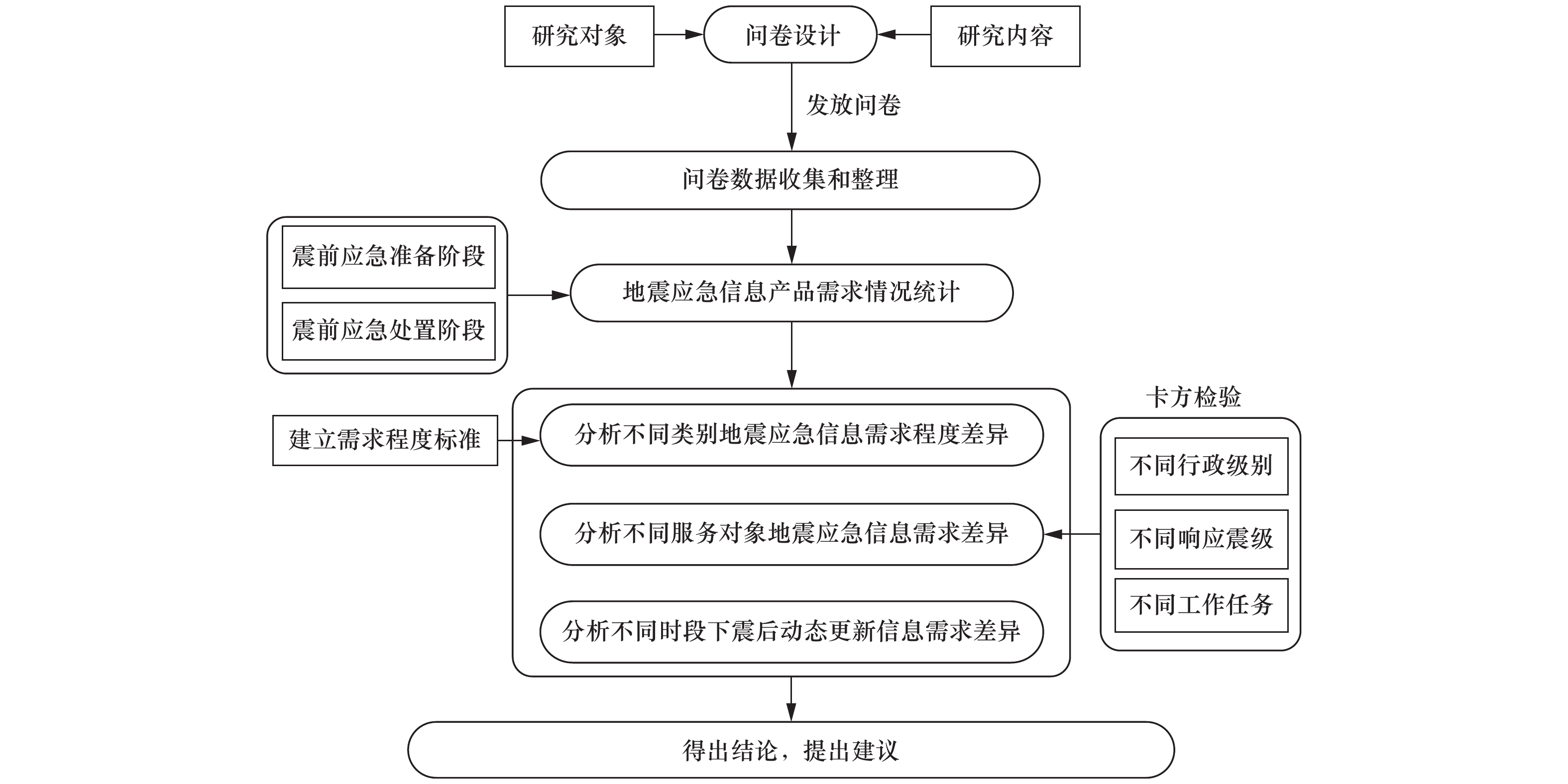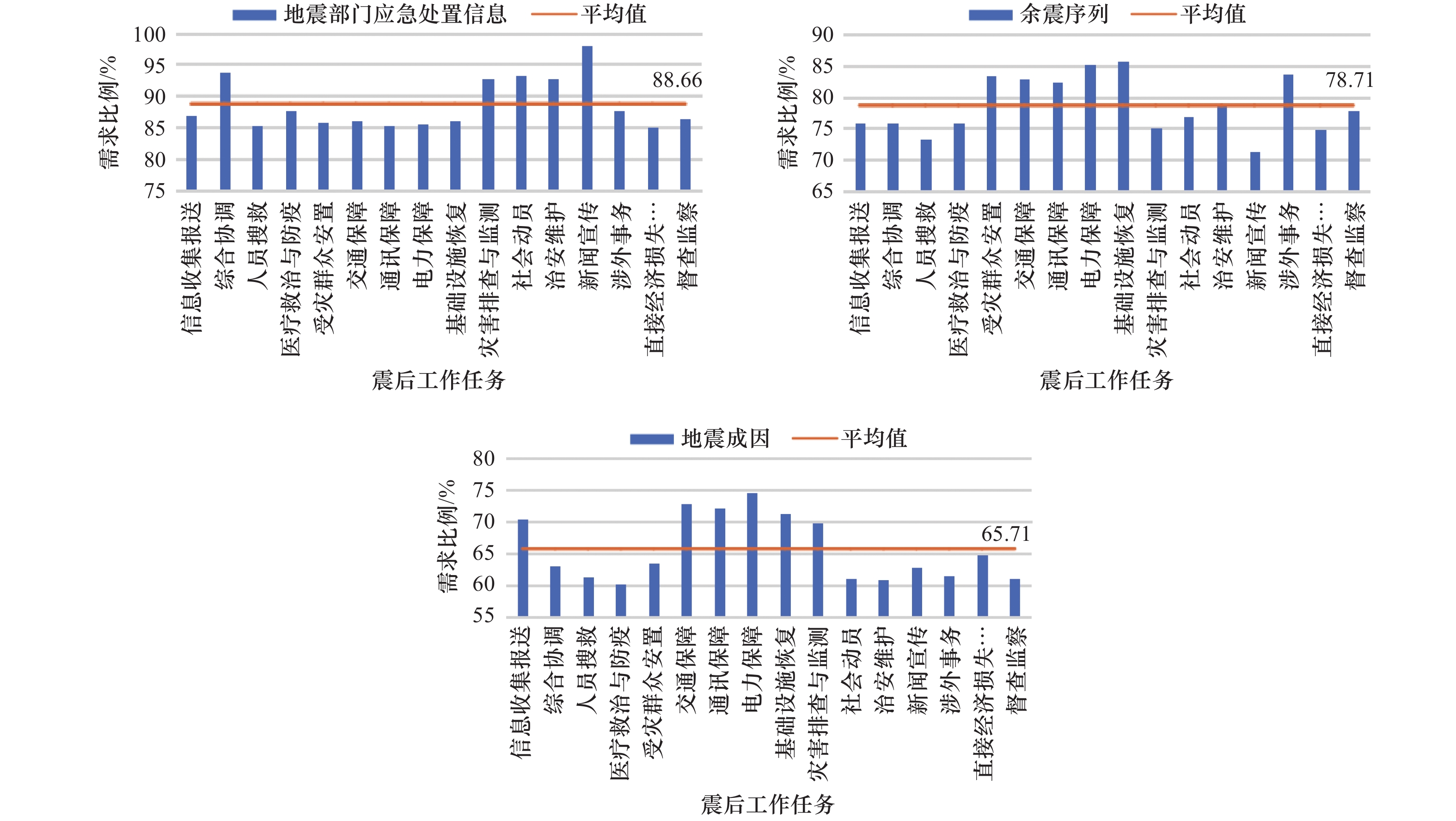Analysis of the Demand for Products of the Earthquake Emergency Information: A Case Study of the Members of the Earthquake Relief Headquarters in Yunnan
-
摘要: 地震应急信息是政府开展地震应急处置决策的重要依据。本文通过云南各级抗震救灾指挥部成员单位为主的政府部门对地震应急信息需求开展问卷调查,结合云南历史震害经验和应急救援经验,采用统计分析和卡方检验方法,分析政府部门对地震应急信息产品的需求情况及差异,提出地震应急信息差异化服务建议。Abstract: The earthquake emergency information is the fundamental basis for government’s decision-making for earthquake emergency response. In our research, we first conduct a questionnaire survey of the government departments’ demand for the products of the earthquake emergency information. These departments are the members of the earthquake relief headquarters at all levels in Yunnan. Then, after reviewing the experience of historical earthquake emergency response in Yunnan, we apply the Chi-square test to a statistical analysis of the departments’ demand for the products of the earthquake emergency information. In this way, we find that different departments have different requirements. On this basis, we put forward some advice on differentiated services for the departments.1) 云南省省人民政府办公厅,云南省人民政府办公厅关于印发云南省地震应急预案的通知(云政办发〔2014〕16号).
-
表 1 调查问卷
Table 1. Contents of the questionnaire
调查项目 调查内容 选项 基本信息 1.您的年龄? A.18~30岁;B.31~40岁;C.41~50岁;D.51~60岁;E.60岁以上 2.您所在的单位? 3.您所在单位在发生多大地震时启动应急响应? A.4.0级以上;B.5.0级以上;C.6.0级以上;D.不清楚 4.您所在单位在震后应急处置的主要工作任务是? A.信息收集报送;B.综合协调;C.人员搜救;D.医疗救治与防疫;E.受灾群众安置;F.交通保障;G.通讯保障;H.电力保障;I.基础设施恢复;J.灾害排查与监测;K.社会动员;L.治安维护;M.新闻宣传;N.涉外事务;O.直接经济损失评估;P.检查督察 震前应急
信息需求5.对于区域地震背景信息,您希望地震部门提供哪些? A.历史地震震中分布图;B.活动构造分布图;C.地震动参数图;
D.烈度区划图;E.地震重点监视防御区分布图;F.地震带分布;
G.其他__6.对于历史地震处置经验信息,您希望地震部门提供哪些? A.历史地震应急处置案例;B.历史地震灾害直接经济损失评估报告;C.其他__ 7.对于区域地震灾害预评估信息,您希望地震部门提供哪些? A.地震人员死亡风险评估图;B.地震房屋破坏风险评估图;C.地震经济损失风险评估图;D.年度地震危险区地震灾害预评估报告;
E.其他__8.对于应急预案信息,您希望地震部门提供哪些? A.地震应急联络信息;B.地震应急预案;C.其他__ 震后应急
信息需求9.对于震情信息,您希望地震部门提供哪些? A.地震三要素;B.地震震中分布;C.震中距;D.地震预警信息;E.强震记录信息;F.余震序列;G.地震成因;H.地震趋势研判意见;I.其他__ 10.对于震区背景信息,您希望地震部门提供哪些? A.震区构造背景信息;B.震区历史地震灾害背景信息;C.其他__ 11.对于震区实时动态信息,您希望地震部门提供哪些? A.地震部门应急处置情况;B.地震烈度调查实况;C.其他__ 12.对于建议参考信息,您希望地震部门提供哪些? A.快速评估信息;B.应急处置对策建议;C.地震有感范围图;D.震区航拍区域建议;E.地震烈度图;F.地震舆情监控报告及地震谣言处置对策;G.其他__ 13. 您在震后0~2 h、2~6 h、6~24 h、24~72 h的哪些时段,
对震后动态更新信息有需求?A.余震序列;B.地震部门应急处置情况;C.地震趋势研判意见;
D.地震烈度调查实况;E.地震舆情监控报告及地震谣言处置对策表 2 地震应急信息需求程度划分标准
Table 2. Grade of the demand of earthquake emergency information and corresponding parameter values
需求等级 划分标准 一般 $Z_{i}$≤−1 中等 −1<$Z_{i}$≤0 高 0<$Z_{i}$≤1 特高 1<$Z_{i}$ 表 3 不同地震应急信息的需求比例
Table 3. Proportions of the demand for earthquake emergency information
分类 调查内容 比例/% 平均比例/% 震前应急准备阶段 区域地震背景信息 历史地震震中分布图 77.5 74.0 活动构造分布图 65.0 地震动参数图 58.6 烈度区划图 71.5 地震重点监视防御区分布图 87.6 地震带分布 83.8 历史地震处置经验 历史地震应急处置案例 78.1 69.5 历史地震灾害直接经济损失评估报告 60.9 区域地震灾害预评估信息 地震人员死亡风险评估图 69.6 70.3 地震房屋破坏风险评估图 73.4 地震经济损失风险评估图 63.5 年度地震危险区地震灾害预评估报告 74.6 预案信息 地震应急联络信息 89.0 88.9 地震应急预案 88.9 震后应急处置阶段 震情信息 地震三要素(时间、地点、震级) 95.0 79.3 地震震中分布 83.6 震中距 92.6 地震预警信息 87.0 强震记录 72.0 余震序列 72.7 地震成因(地震破裂过程、震源机制解) 58.4 地震趋势研判意见 72.8 震区背景信息 震区构造背景信息 61.9 63.1 震区历史地震灾害背景信息 64.4 震区实时动态 地震部门应急处置情况 83.4 78.4 地震烈度调查实况(震害破坏照片、调查点基本信息等) 73.5 对策建议参考信息 震区快速评估信息 87.2 78.8% 应急处置对策建议 89.1 地震有感范围图 84.9 震区航拍区域建议 69.5 地震烈度图 65.6 地震舆情监控报告及地震谣言处置对策 76.6 表 4 震前应急准备阶段不同应急信息的需求程度
Table 4. Demand on the earthquake emergency information for earthquake preparedness
地震应急信息分类 需求等级 特高 高 中等 一般 区域地震背景信息 地震重点监视防御区分布图 历史地震震中分布图、
地震带分布烈度区划图 活动构造分布图、地震动参数图 历史地震处置经验 历史地震应急处置案例 历史地震灾害直接经济损失评估报告 区域地震灾害
预评估信息地震人员死亡风险评估图、地震房屋破坏风险评估图、年度地震危险区地震灾害
预评估报告地震经济损失风险评估图 预案信息 地震应急预案、地震应急联络信息 表 5 (不同行政级别)拒绝H0的地震应急信息产品
Table 5. (Different administrative levels)Products of earthquake emergency information on condition that the null hypothesis is rejected
项目 活动构造分布图 地震带分布 地震动参数图 地震应急预案 方法 Pearson卡方 Pearson卡方 Pearson卡方 Pearson卡方 X2 4.923 4.996 15.133 11.671 df 1 1 1 2 P值 0.027 0.025 0.00001 0.003 注:X2为卡方值;df为自由度;设置显著性水平为0.05,P值小于0.05,拒绝原假设H0,认为结果有显著性差异。所有样本数据预测频数小于5的比例均不超过20%,结果可靠,采用Pearson卡方的P值。 表 6 (不同响应震级)拒绝H0的地震应急信息产品
Table 6. (Different response magnitudes)Products of earthquake emergency information on condition that the null hypothesis is rejected
项目 地震应急预案 方法 Pearson卡方 X2 11.671 df 2 P值 0.003 表 7 (不同行政级别)拒绝H0的地震应急信息产品需求比例
Table 7. (Different administrative levels)Proportions of the demand on the products of earthquake emergency information on condition that the null hypothesis is rejected
行政级别 活动构造分布图
占比/%地震带分布
占比/%地震动参数图
占比/%地方政府部门 66.20 84.70 60.70 省级政府部门 54.10 75.30 38.80 表 8 (不同响应震级)拒绝H0的地震应急信息产品需求比例
Table 8. (Different response magnitudes)Proportions of the demand on the products of earthquake emergency information on condition that the null hypothesis is rejected
震级 地震应急预案占比/% 4.0级以上 80.42 5.0级以上 84.84 6.0级以上 88.41 表 9 震后应急处置阶段不同应急信息的需求程度
Table 9. Degree of the demand on the earthquake emergency information in the stage of post-earthquake response
地震应急信息分类 需求等级 特高 高 中等 一般 震情信息 地震三要素、震中距、
地震预警信息地震震中分布 强震记录、余震序列、
地震趋势研判意见地震成因 震区背景信息 震区构造背景信息、震区
历史地震灾害背景信息震区实时动态 地震部门应急处置情况、
地震烈度调查实况对策建议参考信息 震区快速评估信息、
应急处置对策建议地震有感范围图、地震舆情
监控报告及地震谣言处置
对策震区航拍区域建议 地震烈度图 表 10 (不同行政级别)拒绝H0的地震应急信息产品
Table 10. (Different administrative levels)Products of earthquake emergency information on condition that the null hypothesis is rejected
应急信息
产品地震
成因地震趋势
研判意见方法 Pearson卡方 Pearson卡方 X2 5.258 4.332 自由度 1 1 P值 0.022 0.037 表 11 (不同响应震级)拒绝H0的地震应急信息产品
Table 11. (Different response magnitudes)Products of earthquake emergency information on condition that the null hypothesis is rejected
应急信息
产品地震震中
分布地震部门应急
处置情况震区航拍
区域建议方法 Pearson卡方 Pearson卡方 Pearson卡方 X2 6.500 6.294 6.716 自由度 2 2 2 P值 0.039 0.043 0.035 表 12 (震后不同工作任务)拒绝H0的地震应急信息产品
Table 12. (Different tasks after the earthquake)Products of earthquake emergency information on condition that the null hypothesis is rejected
应急信息产品 地震部门应急处置情况 余震序列 地震成因 方法 Pearson卡方 Pearson卡方 Pearson卡方 X2 27.769 34.261 29.459 自由度 15 15 15 P值 0.023 0.003 0.014 表 13 (不同行政级别)拒绝H0的地震应急信息产品需求比例
Table 13. (Different administrative levels)Proportions of the demand for products of earthquake emergency information on condition that the null hypothesis is rejected
行政级别 地震成因占比/% 地震趋势判断意见占比/% 地方政府部门 47.10 70.50 省级政府部门 59.90 81.20 表 14 (不同响应震级)拒绝H0的地震应急信息产品需求比例
Table 14. (Different response magnitudes)Proportions of the demand for products of earthquake emergency information on condition that the null hypothesis is rejected
震级 地震震中分布
占比/%地震部门应急处置情况
占比/%震区航拍区域建议
占比/%4.0级以上 80.42 85.6 58.59 5.0级以上 84.84 79.8 68.24 6.0级以上 88.41 75.8 74.08 表 15 震后动态更新应急信息的需求比例
Table 15. Proportions of the demand for the dynamically updated earthquake emergency information after the earthquake
震后时间 需求比例 余震序列
占比/%地震部门应急情况
占比/%地震趋势研判意见
占比/%地震烈度调查实况
占比/%地震舆情监控报告及谣言处置对策
占比/%0~2 h 82.88 83.36 ― ― ― 2~6 h 80.86 85.58 76.44 83.89 79.80 6~24 h 79.55 86.42 81.33 83.26 81.30 24~72 h 77.48 88.40 78.88 79.13 84.07 -
[1] 白仙富, 李永强, 陈建华等, 2010. 地震应急现场信息分类初步研究. 地震研究, 33(1): 111—118. doi: 10.3969/j.issn.1000-0666.2010.01.019Bai X. F., Li Y. Q., Chen J. H., et al., 2010. Research on earthquake spot emergency response information classification. Journal of Seismological Research, 33(1): 111—118. (in Chinese) doi: 10.3969/j.issn.1000-0666.2010.01.019 [2] 董曼, 杨天青, 2014. 地震应急灾情信息分类探讨. 震灾防御技术, 9(4): 937—943. doi: 10.11899/zzfy20140423Dong M., Yang T. Q., 2014. Discussion of earthquake emergency disaster information classification. Technology for Earthquake Disaster Prevention, 9(4): 937—943. (in Chinese) doi: 10.11899/zzfy20140423 [3] 高建国, 2004. 地震应急期的分期. 灾害学, 19(1): 11—15. doi: 10.3969/j.issn.1000-811X.2004.01.003Gao J. G., 2004. Discussion on earthquake emergency response term. Journal of Catastrophology, 19(1): 11—15. doi: 10.3969/j.issn.1000-811X.2004.01.003 [4] 宫玥, 申文庄, 2018. 震后地震部门应急信息产出概况与分析. 中国应急救援, (4): 33—37. doi: 10.3969/j.issn.1673-5579.2018.04.009 [5] 胡代平, 雷爱中, 王琪等, 2007. 政府危机管理的信息需求及获取. 科学技术与工程, 7(9): 2177—2181, 2186. doi: 10.3969/j.issn.1671-1815.2007.09.089Hu D. P., Lei A. Z., Wang Q., et al., 2007. Requirement and acquirement of information for government crisis management. Science Technology and Engineering, 7(9): 2177—2181, 2186. (in Chinese) doi: 10.3969/j.issn.1671-1815.2007.09.089 [6] 雷志梅, 王延章, 裘江南等, 2014. 突发事件应急信息的多维度需求分析. 情报科学, 32(12): 133—137.Lei Z. M., Wang Y. Z., Qiu J. N., et al., 2014. Multi-dimensional analysis of emergency information needs. Information Science, 32(12): 133—137. (in Chinese) [7] 聂高众, 安基文, 邓砚, 2012. 地震应急灾情服务进展. 地震地质, 34(4): 782—791. doi: 10.3969/j.issn.0253-4967.2012.04.020Nie G. Z., An J. W., Deng Y., 2012. Advances in earthquake emergency disaster service. Seismology and Geology, 34(4): 782—791. (in Chinese) doi: 10.3969/j.issn.0253-4967.2012.04.020 [8] 苏桂武, 聂高众, 高建国, 2003. 地震应急信息的特征、分类与作用. 地震, 23(3)27—35. doi: 10.3969/j.issn.1000-3274.2003.03.004Su G. W., Nie G. Z., Gao J. G., 2003. The characteristics, classifications and the functions of the information for earthquake emergency response. Earthquake, 23(3): 27—35. (in Chinese) doi: 10.3969/j.issn.1000-3274.2003.03.004 [9] 王海鹰, 李志雄, 张涛, 等, 2016. 地震应急救援信息需求及获取建议. 灾害学, 31(4): 176-180. doi: 10.3969/j.issn.1000-811X.2016.04.031Wang H. Y., Li Z. X., Zhang T., et al., 2016. Information requirement of earthquake emergency response and suggestions. Journal of Catastrophology, 31(4): 176-180. (in Chinese) doi: 10.3969/j.issn.1000-811X.2016.04.031 [10] 张方浩, 李永强, 余庆坤等, 2015. 省级地震应急信息公共服务平台设计探讨. 震灾防御技术, 10(3): 657—663. doi: 10.11899/zzfy20150320Zhang F. H., Li Y. Q., Yu Q. K., et al., 2015. Design of the public service platform for earthquake-emergency information at the provincial level. Technology for Earthquake Disaster Prevention, 10(3): 657—663. (in Chinese) doi: 10.11899/zzfy20150320 [11] 张翼, 唐姝娅, 王悦等, 2016. 地震应急信息产品分类编码研究. 震灾防御技术, 11(1): 132—143. doi: 10.11899/zzfy20160115Zhang Y., Tang S. Y., Wang Y., et al., 2016. Classification and coding of earthquake emergency information products. Technology for Earthquake Disaster Prevention, 11(1): 132—143. (in Chinese) doi: 10.11899/zzfy20160115 -




 下载:
下载:


